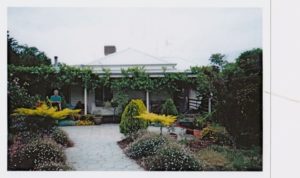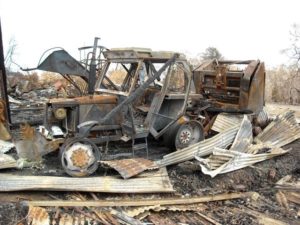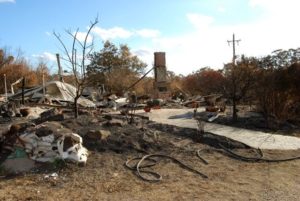SHOULD I stay or should I go?
It’s a tricky question to contemplate and for many people choosing to stay when a fire comes will depend on a number of circumstances. This is determined by whether a person is physically or emotionally capable of surviving the ordeal, whether the building they will stay and actively defend is suitable and whether they have the equipment and water up to the job.
For many, this conversation will lead to the conclusion that leaving early is the safest option.
This means having somewhere that is safe and practical to go and the means to get there.
What the statistics tell us
CSIRO leading bushfire risk expert Dr Justin Leonard and his team at CSIRO had the difficult task of analysing people’s experiences while sheltering in and around their homes during the 2009 February fires in Victoria.
Funded by the Australian Government, the project (and subsequent 2015 report) aimed to examine circumstances and challenges experienced by residents when sheltering in order to establish evidence to support policy reform and community education initiatives. The report states that 1007 people sheltered during fires on Black Saturday, of those people 169 died.
The scientists discovered through statistical analysis that the number of people “actively” sheltering had the strongest chance of surviving. This factor stood out above all others, including obvious factors like forest proximity, in determining probability of survival.
“The people that were proactive while they were sheltering had the best chance of surviving,” Leonard says.
“While they were sheltering inside their home they were monitoring the fire, shutting off rooms that were burning and retreating to an exit. Once the house lost tenability, they would leave the house. This was compared to people who sheltered in a bathroom and didn’t move and were unaware of what was happening around them. Conditions outside may have been survivable but they didn’t know.”
During the 2009 February fires, the bathroom was the most common location where people died. Out of 58 people who sheltered in a bathroom, 38 of them died.
The perceived safety of the bathroom appears to stem from the ready availability of water and the contained nature of the room. Unfortunately this room does not normally provide a direct exit from the house or provide a clear view of how the conditions outside are progressing.
Learning from harsh experience
Malcolm Hackett and Diana Robertson live on a cattle farm at Strathewen, 45km north-east of Melbourne’s CBD. They lost their home and beloved family dog in the Black Saturday fires and have an evolved perspective on how they would survive another major bushfire.

“When the Black Saturday fire came I thought we were well prepared,” Hackett says.
“There was quite a distance between our house and any bushland, the grass area was extensive and mowed to the soil. We had plenty of water from a dam above the house, fire pumps fed by underground poly pipe and four strategically placed hoses to cover the house and machinery shed. I had seen fires before, I was too confident and completely wrong about what would happen.
“Everything ignited when the fire front came through, we had a constant barrage of embers. The embers were phenomenal, you have to think of it like a massive sand storm with everything alight.”
The fire front passed quickly and Hackett stayed outside the house with two hoses spraying a huge fan of water into the wind driven embers.
“It was tense but we were doing well,” he says.
However he now believes it doesn’t matter how many fire hoses you have, you can’t be everywhere at once when there's only two of you.

“I watched the fire creeping towards the machinery shed but couldn’t leave the house. So after 15 minutes of fire fight I wrote off $150,000 worth of machinery. Then Diana called out to me that the bungalow adjacent to the house was on fire but I still couldn’t leave the house.
"We wrote off thousands of LPs and CDs and a huge library of books and memorabilia from our travels. We had too many vulnerabilities to address at once.”
Not long after, the couple lost water because the poly pipe under the ground wasn’t deep enough in places and the pine tree roots had burned down and melted holes in the poly. Then one old unpainted, dry rotted window caught fire first from an ember and in a few seconds the fire was in the main homestead’s roof cavity before engulfing the entire home.
It took about 10 minutes before the house was fully engulfed.
The couple was picked up by the Country Fire Authority (CFA) but lost their dog Harry in the commotion.
“I learnt that Plan A needs a backup ranging from Plan B probably through to XYZ. If something can go wrong it will. We were safe in reasonably open land outside the house, that was our Plan Z,” Hackett says.
“There’s houses near here in the bush that I would never take the risk of staying at.”

With advice from bushfire authorities and fire scientists such as Leonard, the couple rebuilt a rammed earth house with measures including aluminium window frames, well-sealed roof cavity, Colorbond steel verandah beams and even moved their home to a less “flammable” location.
They started rebuilding in January 2013. It took over three years and they only moved into their new home in July 2016.
“Our experience of Black Saturday remains the most likely scenario for a fire in the future,” Hackett says.
“A fire travelling from the north-west but south of Strathewen turns late in the afternoon on the south westerly change and pushes up the Strathewen Valley. We hope to be better prepared with a bushfire plan and the design of our home should help.”
Looking for a safe way out
Approximately 173 people died, 414 were injured and 2,000 homes were lost in the 2009 Black Saturday bushfires prompting the 2009 Victorian Bushfires Royal Commission.
The commission resulted in a number of community education initiatives including the promotion of bushfire plans for each household and the establishment of community fire refuges in remote and fire-prone locations in Victoria.
CSIRO bushfire experts were again called upon to act as science advisors on an expert panel set up by Emergency Management Victoria for establishing fire refuges. A Community Fire Refuge is a purpose built or modified building which can provide protection from radiant heat and embers. They are designed to be a last resort option where residents or visitors can seek shelter in the event they are trapped by a significant fire.
There are five buildings designated as Community Fire Refuges in Victoria at Millgrove, East Warburton, Ferny Creek, Blackwood and most recently at Lavers Hill. For people living in Victoria the message is to always leave early. For your own safety, you need to understand your fire risk and plan ahead, and plan for all situations.
Emergency Management Commissioner Craig Lapsley says decision making is critical in emergencies, which is why we ask people to plan and prepare ahead.
“The potential consequences of fire mean that decisions you make and how you plan, prepare and respond to a fire is important.
“Making the right decisions early is integral to the safety of you and your family.
“The daily Fire Danger Rating forecast will help you when you decide when to leave early based on the fire conditions and people should always monitor conditions on hot, dry, windy days.
“They also tell you how dangerous a fire would be if one started and how hard it would be to put out. The higher the rating the more dangerous the conditions.
“If it is Code Red, Extreme or Severe, you are risking your life if you wait and see. Leaving early is always the safest option to protect yourself and your family.”
Unfortunately attempting to reach and use a refuge is not without risk. There is always the prospect of not reaching the refuge before the fire arrives.
“Leaving late when there is a fire is the worst option you could take,” Leonard says. “Recognizing when it is too late to safely travel to a refuge is also a critical part of a bushfire plan, the majority of people that died outside in the Black Saturday bushfire were less than 200m from their own home.”
Refuges operate on days of Severe, Extreme or Code Red fire danger. They are in locations that are quite remote where it takes a long time to get out of the area by car.
Many areas in Victoria are already in the Fire Danger Period; Leonard believes property management, personal bushfire plans and a knowledge of proactive sheltering are an essential part of being prepared.
“You do have to plan for all contingencies, every possible scenario,” he says.
“We can’t predict the likelihood of extreme fire events this early in the season but we can get comfortable with planning for them.”
You can read more stories about Strathewen via Big Stories Small Towns.
